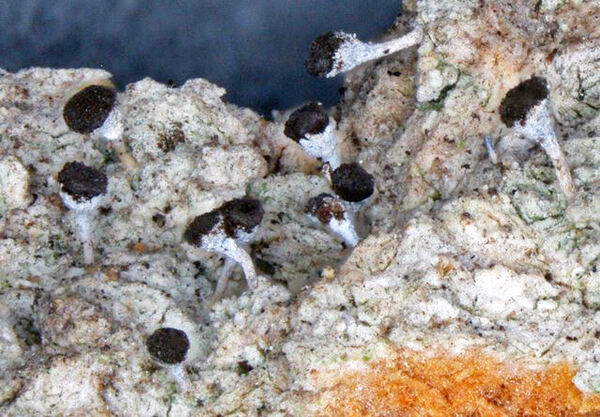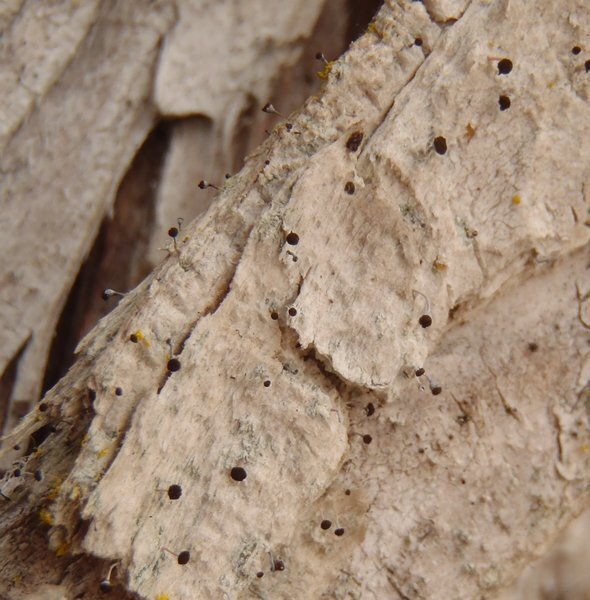Chaenotheca cinerea (Pers.) Tibell
Symb. Bot. Upsal., 23, 1: 30, 1980. Basionym: Calicium cinereum Pers. - Ic. Descr. Fung. Minus Cogn., 2: 58, 1800.
Synonyms: Calicium schaereri De Not. non auct.; Chaenotheca albida (Körb.) Zahlbr.; Chaenotheca schaereri (De Not.) Zahlbr.
Distribution: N - Ven (Puntillo & Puntillo 2009), Lomb (Anzi, Lich. Rar. Langob. Exs. Nr. 204: S-L30504).
Description: Thallus crustose, episubstratic, granular-verrucose, grey-white, more rarely almost endosubstratic and poorly evident. Apothecia short-stalked, pin-like, 0.6-1 mm high. Upper part of stalk dark, but covered in a thick white pruina, lower part pale brown to almost white. Outermost layer of stalk hyaline, consisting of periclinally arranged, strongly gelatinized hyphae: Capitulum 0.2-0.4 mm across, obovoid to obconical, with a well-developed excipulum; inner part of excipulum consisting of periclinally arranged, medium brown hyphae, outer part of irregularly intertwined, swollen and sclerotized hyphae; lower side of excipulum white-pruinose, edge often with irregular vertical splits. Mazaedium well-developed, brown; hypothecium pale brown to colourless, with a concave upper surface. Asci ellipsoid or irregular, formed in chains from hooked ascogenous hyphae, dissolving early, with uniseriate ascospores. Ascospores 1-celled, brown, globose, 4.5-5.5 µm wide, the wall smooth or with irregular cracks. Photobiont chlorococcoid, with rectangular cells (Stichococcus). Spot tests: thallus K-, C-, KC-, P-. Chemistry: thallus with very low amounts of atranorin and other unidentified substances.Note: a mild-temperate species found on the nutrient-rich bark of several trees (e.g. Acer, Fraxinus, Populus, Ulmus), in deep fissures of the bark seldom wetted by rain, with optimum at low elevations. Known from a few regions of the North but extremely rare and perhaps extinct. It is included as “Regionally Extinct” in the Italian red list of epiphytic lichens (Nascimbene & al. 2013c).
Growth form: Crustose
Substrata: bark
Photobiont: green algae other than Trentepohlia
Reproductive strategy: mainly sexual
In underhangs rarely wetted by rain
Commonnes-rarity: (info)
Alpine belt: absent
Subalpine belt: absent
Oromediterranean belt: absent
Montane belt: absent
Submediterranean belt: extremely rare
Padanian area: absent
Humid submediterranean belt: absent
Humid mediterranean belt: absent
Dry mediterranean belt: absent

Predictive model
Growth form: Crustose
Substrata: bark
Photobiont: green algae other than Trentepohlia
Reproductive strategy: mainly sexual
In underhangs rarely wetted by rain
Commonnes-rarity: (info)
Alpine belt: absent
Subalpine belt: absent
Oromediterranean belt: absent
Montane belt: absent
Submediterranean belt: extremely rare
Padanian area: absent
Humid submediterranean belt: absent
Humid mediterranean belt: absent
Dry mediterranean belt: absent

Predictive model
 Index Fungorum
Index Fungorum
 GBIF
GBIF





